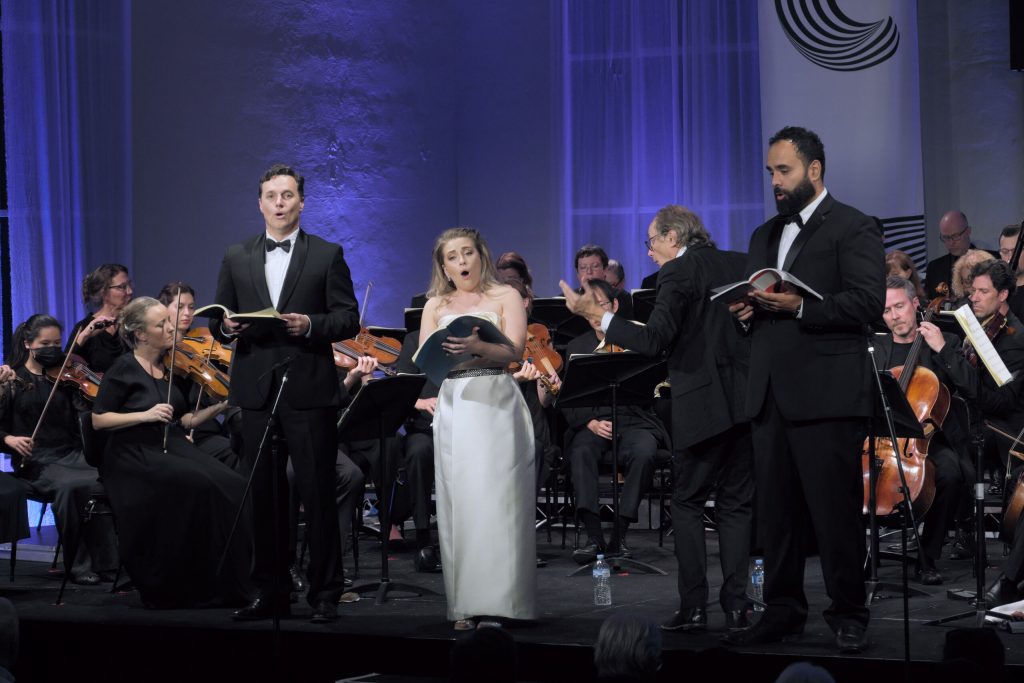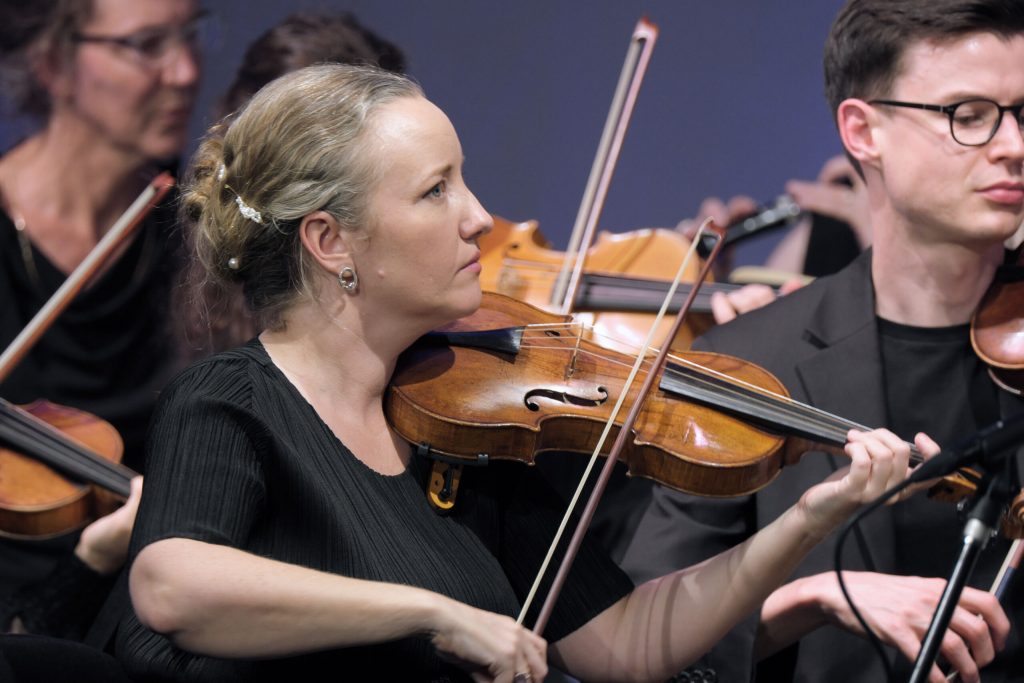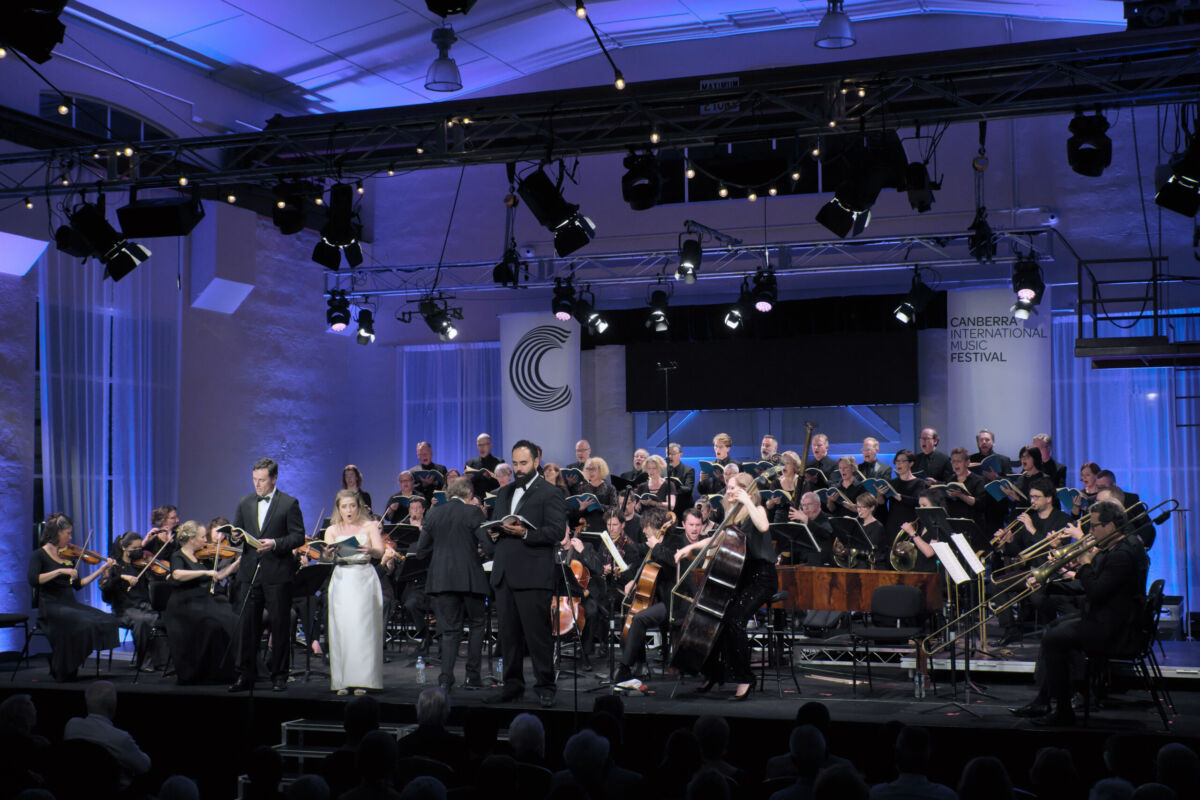Australia’s first-ever period-instrument presentation of The Creation revealed the fresh vitality and range of colours in Haydn’s score.
“This is one of the Canberra International Music Festival’s most ambitious presentations yet,” declared Tara Cheyne, the ACT’s Minister of the Arts. She was echoing the comments of CIMF Chair, Genevieve Jacobs, opening the 2022 festival season built on the concept ‘Pole to Pole’. Jacobs depicted Canberra’s beloved festival apparatus as “this big, warm, sometimes messy family”. Looking over the 70 or so performers crammed onto that small stage of The Fitters’ Workshop in Kingston, we wondered where CIMF might go in future years.
This occasion was the first of two Gala Performances of Haydn’s oratorio The Creation completed in 1798. Once a staple in the choral society repertory throughout the world, Haydn’s sprawling 150-minute masterpiece is not so often performed these days. Perhaps because it was written in the long shadow of Handel, perhaps because of its contested Anglo-German origins, perhaps because the oratorio form itself has become old-fashioned, perhaps because the old theology, or even the Bible itself, is not so widely read nowadays. Or is it just too long to endure in an uncomfortable setting? (And, heaven knows, the CIMF Director would never, ever countenance cuts!) Whatever the case, we can dispense with any religious misgivings preceding the Age of Enlightenment, and experience the work as music.
And what splendid music it is too! Haydn divides the Creation of the World into three parts, encompassing the seven days of creation. Three soloists take on narrator roles, as assorted angels, even Biblical characters like Adam and Eve. As in Bach and Handel, a mixed chorus provides reflective moments of commentary and reflection. A full Classical-size orchestra paints from a vivid palette of colours and moods.

There is little doubt that this CIMF presentation was the first period-style performance ever in Australia. This is hardly a high claim, as the ‘original instruments’ style didn’t really take root here until about 50 years ago, some time after its Dutch, British and Boston forebears. On this occasion, the 33 players of the Australian Haydn Ensemble, led by violinist Skye McIntosh, brandished their own period instruments, setting aside customary practices such as vibrato and exaggerated tempos and dynamics. A lower pitch (A=432) was deployed, unfurling new ribbons of colours.
Similarly, the 33 members of the Sydney Chamber Choir, directed by Sam Allchurch, provided exemplary models of what a Classical chorus would have sounded like. On the whole, the three soloists were reasonably well matched, and all had near-perfect diction. That was helped by projecting the text above the performers.
That impressive Sydney-based tenor Andrew Goodwin stepped from his Evangelist’s pulpit to create truly dramatic roles. The New Zealand baritone, James Ioelu, has a beautiful range of colours and dynamics, but took a little while to settle into his roles. It will be instructive to hear him later in the week (12 noon, Sunday 8 May) in a more extended guise when he sings Vaughan Williams’s Songs of Travels.
The undisputed vocal star of the evening was soprano Alexandra Oomens. Not yet 30, this Sydney-born but now London-trained/based singer flew into Australia three days prior to these performances and will fly out again three days after them. Oomens is a real star to watch for, engaging and glamorous on stage, equally at home in Janáček operatic roles and oratorio performances. Pitch-perfect, she has a clear and light, ringing tone, even in all registers. Peelman can be well proud of his ‘discovery’, and we hope Oomens will be a regular member of his CIMF family, perhaps featuring in recitals and contemporary music too.

Peelman approached this quite massive enterprise with characteristic authority and flair. Everything he performs is well researched and documented and meticulously presented. Either as conductor or pianist, he is able to draw from his singers and instrumentalists compelling performances. Their enthusiasm is communicated undiluted to audiences who are happy to travel wherever Peelman leads them. From one Pole to another.
For this listener, what emerged from this Creation – perhaps for the first time in over 30 years – was the fresh vitality and range of colours in Haydn’s score. The very opening, Prelude to Chaos, remains one of the most graphic depictions in all music; it even figures frequently in programs of contemporary music. The explosion on the word “Light” is forever startling, causing audiences to wake in a start or jump from their seats. The descriptions of the creation of the animals and plants – the growling of beasts and twittering of birds, the lumbering of the worm – are all pre-Fantasia. The love-duet of Adam and Eve is as heart-felt as that of Tristan and Isolde. Slowly it dawned on this listener that, with reduced orchestra playing on period instruments, we were hearing authentic Haydn, the playful Haydn of the opera theatre, Mozart’s buddy, more extrovert Baroque than interior Classical. This was most vividly illustrated in the dynamic, even somewhat cheeky fortepiano continuo of Chad Kelly playing on one of the prized instruments in the Australian National University’s Keyboard Institute collection.
What impressed also was the sheer stamina of the performers. By Sunday evening, all 70 will have acquitted four full Creations in four days: at least one full rehearsal together, two CIMF performances and a performance in Sydney. It would have been interesting to compare the Canberra performances in the Fitters’ Workshop with that in Angel Place on Sunday evening. That would surely magnify the deficiencies in the venue in Canberra.
Since Christopher Latham, Peelman’s predecessor as CIMF’s Artistic Director, first introduced Canberra to the Workshop with performances of Peter Sculthorpe’s Requiem in 2009, I have been critical of the Fitters’ Workshop as a concert venue. (Long story, to be developed over the coming days.) Hardly a popular view, admittedly, yet I sense that, with each passing festival, more and more Canberrans are realising that a 400-seat hall dedicated to small performances of chamber and vocal music is sorely needed. Until then, they will not be able to hear the music properly. Until then, Canberra can hardly claim pre-eminence in Australia’s music and culture landscape.
Funding is always the bugbear. There is never enough, especially for the Arts, as Minister Cheyne knows all too well. With around another $600m proposed for upgrading the football stadium in nearby Manuka, there must be another solution. Is there an Ian Potter or a mining/media magnate who will step up to the mark?
This article was written by Vincent Plush from Limelight Magazine.
Featured Article: CIMF 2022. Concert 2. The Creation. Australian Haydn Ensemble, Sydney Chamber Choir and soloists conducted by Roland Peelman. Photo by Peter Hislop.
